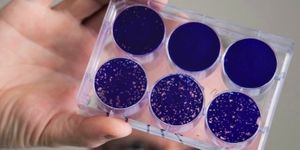The Rise of Theranostics
Theranostics: one stone can kill two or three birds. Credit: Ko et al. 2014/Clinical Endoscopy
This September the Journal of Nuclear Medicine has published a supplement that focuses on theranostics and its increasingly important role in the delivery of precision medicine. By definition, theranostics means a combination of diagnostic and therapeutic functionalities into one single application. It is an emerging field that unifies multiple disciplines such as nanotechnology, molecular medicine, biochemistry, and material science to provide personalized diagnosis and treatment. The idea of theranostics has a humble origin. When the first study on radioiodine therapy for metastatic thyroid cancer was published in 1946, it started a new era of clinical intervention. The work represented the first successful attempt to combine diagnostic imaging, target-expression confirmation, and radionuclide therapy in one single clinical application. As time went by, the procedures evolved as well. Sodium iodide (iodide as two different iodine isotopes I-124 and I-131) has become an important method for thyroid cancer monitoring and treatment.
Nowadays the use of theranostics has gone much beyond thyroid cancer. Take the diagnosis and targeted treatment of prostate cancer for example, the elevated expression of prostate-specific membrane antigen (PSMA) among cancer tissues provides a perfect biomarker for the development of theranostic agents. According to a report earlier this year, a team of German researchers has come up with a PSMA-specific probe is labeled with positron emitting isotope gallium-68 and an infrared dye. It allows PET imaging for diagnosis and confirmation of tumor, as well as intraoperative gamma and fluorescence imaging that guides surgeons through tumor resection.
Another area where theranostics has garnered substantial momentum is the peptide receptor radioligand therapy (PRRT). PRRT is a radioisotope-incorporated molecular therapy used to treat a specific type of cancer called neuroendocrine tumors (NET). Lutetium(Lu)-dotatate is a somatostatin analogue peptide currently in development for the treatment of gastroenteropancreatic neuroendocrine tumors. It allows for precise targeting of carcinoid tumors. Its labeling isotope Lu-177 can deliver therapeutic radiation and enable SPECT imaging for treatment monitoring. The probe has received orphan drug designation from the European Medicines Agency (EMA) and the US Food and Drug Administration (FDA).
Commenting on the status of theranostics, Dr. Wolfgang A. Weber at Memorial Sloan Kettering Cancer Center (MSKCC) said: "Theranostics is the future of precision medicine. Therapies are not selected based on genetic mutations that may or may not be present in all cancer cells but on imaging the whole patient and determining if a specific treatment can be effective. Because of the specific targeting of the cancer cells, theranostic agents are extremely well tolerated."
Being the chief of the Molecular Imaging and Therapy Service at the MSKCC and a leading expert in the field, Weber sees the practice-changing impact that theranostics can bring into the field of nuclear medicine. Although imaging modalities such as PET/CT, PET/MRI, and SPECT/CT currently command the most attention, theranostics will bring therapy and patient care to the center of nuclear medicine. In his opinion, the field “will change from ‘nuclear radiology’ to true ‘nuclear medicine’.”
Weber emphasizes, "The most important future development is to combine theranostics with other cancer therapies and use theranostics earlier in the course of disease in order to achieve not only prolongation of survival, but cures."
Theranostics: from Targeting and Imaging to Tissue Engineering. Credit: TAUVOD









